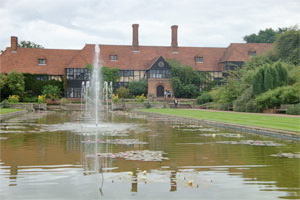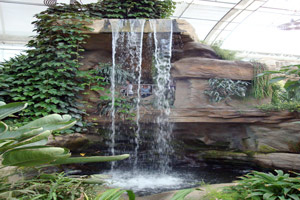RHS Garden Wisley – an intimate and inspirational garden
 My first visit to the Royal Horticultural Society (RHS) garden at Wisley rather reminded me of the old Chinese proverb – ‘one who plants a garden, plants happiness.” To say I was like a child in a sweet shop would be an understatement; I was completely enthralled with Wisley finding it one of the most enjoyable visits I have ever made to a garden.
My first visit to the Royal Horticultural Society (RHS) garden at Wisley rather reminded me of the old Chinese proverb – ‘one who plants a garden, plants happiness.” To say I was like a child in a sweet shop would be an understatement; I was completely enthralled with Wisley finding it one of the most enjoyable visits I have ever made to a garden.
RHS Garden Wisley is one of the great gardens of the world. More than just a collection of plants it is a wonderful source of inspiration, education and enjoyment. The site encompasses all that is good about gardening and growing whether it be perennials, vegetables, grasses, tropical plants or inspiration for the future. Wisley has it all and herein lies one of its greatest strengths.
I was welcomed to RHS Garden Wisley by Nigel Eaton, Head of the Plant Centre who gave me a thorough briefing on what not to miss. Nigel explained that some 90 staff are employed to look after the garden itself and when one judges the variety of planting, layout and size of RHS Wisley that comes as no surprise.
Wisley started life as a ‘wild garden’ known as Oakwood. It was purchased in 1878 by George Fergusson Wilson, one-time treasurer of the RHS and a keen amateur gardener. When he died in 1902 the garden came up for sale – however, the RHS did not have the means to purchase it at that time and so it was bought by Sir Thomas Hanbury who in turn gave the garden to the RHS in perpetuity. This solved a number of problems for the RHS in that ultimately it was to save the society – which had suffered financial difficulties for a number of years – and it provided a wonderful experimental garden consisting of nearly 60 acres away from the pollution of London.
During the first year of RHS ownership in 1905 some 6,000 people visited Wisley, last year that figure had reached a million! Over the decades Wisley has continually expanded until it reached its present 260 acres with the crowning glory of the Bicentenary Glasshouse, opened in 2007, providing a focal point at the western part of the garden.
Wisley is a garden where you can learn about companion planting, continuation and construction. One of its main aims is to enlighten the gardener on how to plan for succession planting so that no part of the season need be dull or flat. Consequently, there is always something to see at Wisley no matter what season you go.
On entering the garden one of the first buildings you see is the half-timbered, Surrey-style building known as the Laboratory which is a focal point of the garden. Purpose built in 1914-16 the building accommodates the Society’s scientific staff and houses a lecture theatre and classrooms for the School of Horticulture. In this area a canal leads away from the house to a loggia giving entrance to a delightful walled garden.
There are several stunning areas of the garden where the visitor can see mixed and herbaceous plantings that change through spring, summer and autumn. There are two rose gardens – the Golden Jubilee Rose Garden and The Bowes-Lyon Rose Garden. The Bowes-Lyon Rose Garden has been completely re-modelled in a contemporary style, providing a focal point for the centre of the garden.
 Wisley is about education, inspiration and ideas and to this end the visitor will find the Model Gardens ideal for showing you how to have something of interest in the garden through the four seasons. Here you will find a town garden; container garden; bonsai garden and family garden all full of ideas and interest. The Daily Telegraph Reflective Garden is here (Best Garden in Show at the 1999 Chelsea Flower Show) and an enthusiast’s garden, designed by Robin Williams, to focus on design and planting associations.
Wisley is about education, inspiration and ideas and to this end the visitor will find the Model Gardens ideal for showing you how to have something of interest in the garden through the four seasons. Here you will find a town garden; container garden; bonsai garden and family garden all full of ideas and interest. The Daily Telegraph Reflective Garden is here (Best Garden in Show at the 1999 Chelsea Flower Show) and an enthusiast’s garden, designed by Robin Williams, to focus on design and planting associations.
Plant trials continue to form an important element of the Society’s work and at Wisley a visit to the Trails Field is not to be missed. On our visit the Clematis trials were in full production, making a stunning sight. The Award of Garden Merit is intended as a practical guide for the ordinary gardener and is granted to plants which are proved to be excellent for ordinary garden use, available and of good constitution. They need to be reasonably easy to grow and reasonably resistant to pests and diseases and finally essentially stable in form and colour. There are currently 7,000 AGM plants with new awards being made each year.
The Model Vegetable Garden demonstrates the growth of a wide variety of vegetables both hardy and tender plus ideas for composting. Over on the Fruit Field and Jubilee Aboretum you can find fruit demonstration gardens with ideas for obtaining a good yield from hardy fruits in a small garden.
The Wild Garden maintains the spirit of George Fergusson Wilson’s original garden where you will still see his ethos of ‘growing difficult plants successfully’ in practice. Sit on the raised area in front of the Alpine greenhouses and get a superb view across the garden to the Glasshouse before inspecting The Rock Garden and Alpine Meadow. Here is another area where you will want to linger especially if you see the grassy slope next to the Rock Bank Garden carpeted in sulphur-yellow hoop-petticoat daffodils in March and April.
When we reached the Glasshouse – after meandering through the wonderful garden planted by Tom Stuart-Smith and admiring the borders planted by Piet Oudolf, we thought it couldn’t get any better until we entered the Glasshouse itself.
Funded largely by private donations, the £2.5 million Glasshouse is a showpiece of design. Designed by architect Peter van de Toorn Vrijthoff, the Glasshouse consists mainly of curved sheets of tempered glass, covering an area equal to ten tennis courts and allowing for 80 per cent of the available light.
The three zones – moist temperate, dry temperate and tropical – are to say the least stunning. The architect has also cleverly incorporated a lift, carefully hidden in a cave, so that no-one need miss out on the higher elevation of the Glasshouse.
The facilities for children at Wisley are also excellent and during our visit there were plenty of ‘future gardeners’ enjoying the garden and events at the Clore Learning Centre. The Learning Centre offers hands-on experience to gardeners of all abilities and ages, from primary-school age upwards. The Teaching Garden designed by Cleve West, is intended to work as a curriculum resource for adults and children. With plenty of interactive facilities to stimulate young minds, Wisley has taken special care to make younger visitors fully inclusive.
For those with mobility problems the garden has the benefit of an electric vehicle which makes several stops around the garden. The guide map given to visitors clearly outlines which areas are easily accessible by wheelchair and which areas more difficult to tackle which is very useful on such a large site.
Another plus for Wisley is the fact that they have carefully situated tea and coffee outlets around the site so you are really never too far away from a sit down and a snack. There is also the Terrace Restaurant, the perfect place for lunch or afternoon tea.
As one might imagine the Plant Centre is not to be missed and for those who need to research any aspect of horticulture there is the Wisley Garden Library. Nigel explained that visitors were welcome to go along to the plant centre or telephone with enquiries regarding obtaining specialist plants even if it might be several months or years before the order can be fulfilled! Gardeners are, if nothing else, patient but if you really cannot wait for that special plant there are some 10,000 plants stocked in the Wisley Plant Centre so no need to despair! Visitors are encouraged to consult staff at the information desk who can give helpful advice which can be very important when you are looking for a specific variety or suitable plant for a particular area and climate.
There is an excellent shop selling a wide range of gifts, books and cards so you need to allow time to fit in your bit of retail therapy before you leave if you haven’t already exhausted yourself in the Plant Centre.
During August all children aged 16 or under go free when accompanied by an adult so it is an excellent time to introduce them to the wonders of gardening. One of the benefits of RHS Membership is that admission to Wisley and the other three gardens belonging to the RHS are free. For the full benefits of RHS membership visit www.rhs.org.uk/join
Log onto www.rhs.org.uk/gardens/wisley for more information and details of garden events throughout the year.
My thanks to Nigel and the RHS Staff for making our visit to Wisley such a memorable and enjoyable day, not to mention the part played by the plants themselves.

